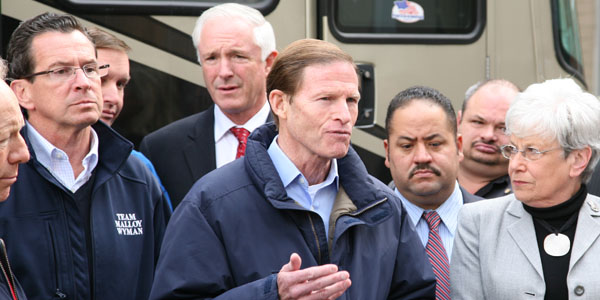
As Congress seeks a bipartisan deal to avert the fiscal cliff, lawmakers have yet another billion-dollar item on their agendas.
The governors of New York, New Jersey and Connecticut last week requested nearly $83 billion in federal aid to assist with infrastructure improvements in areas damaged by Hurricane Sandy.
Gov. Dannel P. Malloy has requested $3.2 billion in federal aid for Connecticut.
“The storms that have impacted the state over the past few years have clearly demonstrated the need to upgrade our utility systems, flood protection and water and sewage infrastructure,” Malloy said in a statement. “While Connecticut made good progress last year in municipal readiness and preparation, mitigating future damage requires strong partnerships with our federal partners and additional resources from Washington.”
Of the $3.2 billion requested by Malloy, nearly $2.5 billion would go toward upgrading power transmission systems, hardening and replacing infrastructure, burying power lines and financing the construction of micro-grids, which are envisioned as backup electrical generation sources that could power select areas or essential facilities in the event of an outage.
Another $620 million would be used for flood prevention and storm mitigation measures at the municipal and state levels.
A Malloy aide acknowledged that ongoing Congressional negotiations concerning the so-called fiscal cliff could delay any funding approvals.
“Adding a rather large spending bill without offsets could lead to complications,” said Dan DeSimone, director of the Malloy administration”™s Washington, D.C. office.
If Congress fails to act on the fiscal cliff, about $600 billion in tax increases and spending cuts would begin to take effect Jan. 1, 2013, with the expiration of Bush-era tax cuts and with sweeping defense and discretionary cuts set to begin.
In order for any funding to be appropriated to states for the rebuilding and shoring up of storm-damaged infrastructure and property, Congress would need to draft a bill, schedule hearings and make a series of other determinations prior to any vote, DeSimone said.
He said a best-case scenario would be if Congress were to pass a Sandy-related funding bill between now and the New Year, but added it was likely for any action to be pushed into 2013.
To complicate matters, in a conversation that took place the day after Malloy submitted the state”™s $3.2 billion funding request, U.S. Sen. Richard Blumenthal said he was not aware of any formal request for funding having been made by the state.
However, Malloy representatives said they have since discussed the state”™s post-Sandy funding needs with each of the members of the Connecticut Congressional delegation.
The governor, along with Sens. Blumenthal and Joseph Lieberman, discussed the state”™s funding request Dec. 3 with the Obama administration”™s budget chief, Jeffrey D. Zients, who currently serves as acting director of the Office of Management and Budget.
Blumenthal and U.S. Rep. Jim Himes of Greenwich are among those who have testified to Congress on the need for federal aid in the states hardest-hit by Hurricane Sandy.
“We”™re working hard and fighting for as much money as quickly as possible,” Blumenthal told the Business Journal. “We need to come together to address the long term dangers of the new normal, which are devastating.”
While acknowledging that most of Hurricane Sandy”™s damage occurred in New York and New Jersey, the governors have been collaborating in hopes of securing as much aid as Congress is able to allocate.
In a joint statement, Malloy and N.Y. Gov. Andrew Cuomo noted that the two states have strong economic ties.
“When one of us suffers from a tragic event like Storm Sandy, we all suffer. Therefore, we have a responsibility, as a region, to push for federal investment,” Cuomo said. “We can”™t plan for every eventuality, but we can make investments that are clearly necessary.”



















